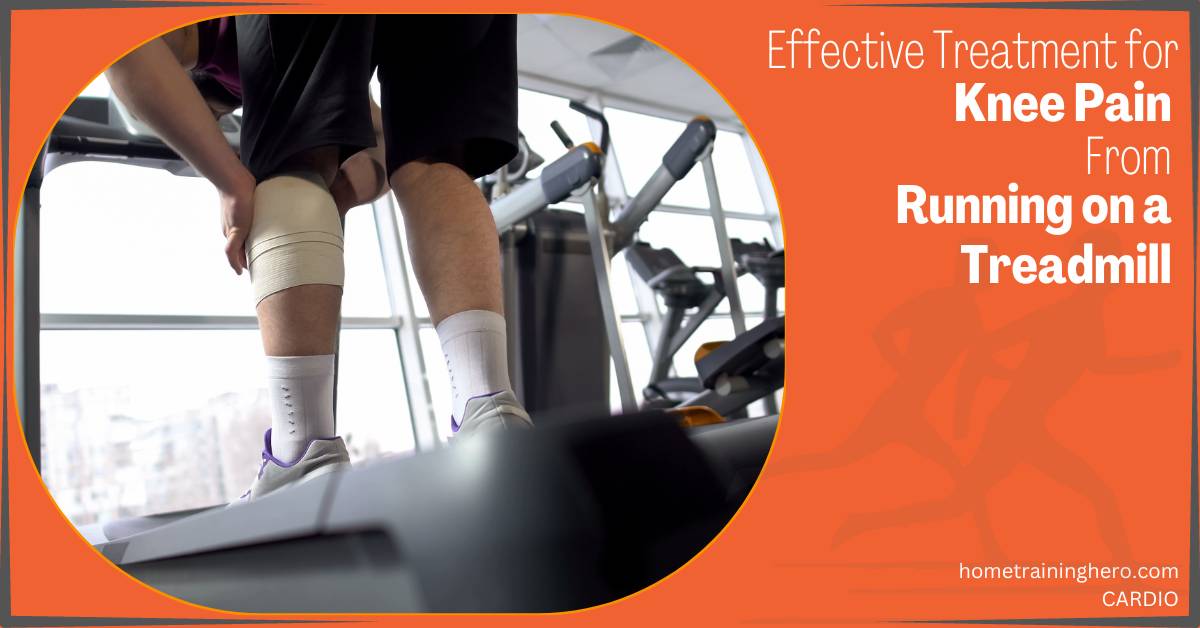Dealing with knee pain from running on a treadmill can be incredibly frustrating and hinder your fitness goals.
The constant pounding on your knees can lead to discomfort, inflammation – and even injury. However, there are effective treatments available that can help alleviate pain and get you back on the treadmill in no time. In this article, we will explore various treatment options for knee pain caused by running on a treadmill and provide you with practical solutions to overcome this issue.
Let’s get to it!
Contents
Understanding Knee Pain from Running on a Treadmill
Before diving into the treatments, it’s crucial to understand the root causes of knee pain when running on a treadmill. The repetitive impact on the knees during running can lead to various conditions such as patellofemoral pain syndrome, iliotibial band syndrome, and runner’s knee.
1. Patellofemoral Pain Syndrome: This condition occurs due to imbalances or weaknesses in the muscles surrounding the kneecap. Excessive stress on the patella (kneecap) while running can lead to pain and discomfort.
2. Iliotibial Band Syndrome (ITBS): The iliotibial band is a thick band of tissue that runs from the hip to the knee. When this band becomes tight or inflamed, it can result in knee pain during running.
3. Runner’s Knee (Patellofemoral Pain): Runner’s knee is a broad term that encompasses pain around the kneecap. It often occurs due to poor biomechanics, muscle imbalances, or overuse.
Treatment Options for Knee Pain from Running on a Treadmill
1. Rest and Ice
Rest is crucial when it comes to healing knee pain caused by running on a treadmill. Avoid activities that exacerbate the pain and provide ample time for recovery. Applying ice to the affected area can help reduce inflammation and alleviate discomfort. Ice the knee for about 15-20 minutes every couple of hours for the first few days.
2. Strengthening Exercises
Engaging in specific exercises that target the muscles around the knees can help improve stability and reduce stress on the joint. Strengthening the quadriceps, hamstrings, and glutes can assist in maintaining proper alignment and reducing the risk of knee pain while running on a treadmill.
3. Stretching and Flexibility Exercises
Incorporating regular stretching and flexibility exercises into your workout routine can help improve the range of motion in your knees and prevent tightness. Focus on stretches that target the quadriceps, hamstrings, and IT band. A combination of static and dynamic stretching can be highly beneficial.
4. Proper Footwear
Investing in good-quality running shoes that provide adequate support and cushioning can make a significant difference in reducing knee pain. Look for shoes that offer stability, shock absorption, and a comfortable fit. Consider visiting a specialized running store to get your gait analyzed and find the right pair of shoes for your specific needs.
5. Gradual Increase in Intensity
One common mistake that runners make is increasing their intensity or mileage too quickly. This sudden change can put excessive strain on the knees and lead to pain. Instead, aim to gradually increase your running distance and intensity over time. Listen to your body and give it enough time to adapt to the demands of running on a treadmill.
6. Cross-training and Low-Impact Activities
If knee pain persists, consider incorporating cross-training exercises and low-impact activities into your fitness routine. Swimming, cycling, and using an elliptical machine are excellent alternatives that provide cardiovascular benefits without putting excessive stress on your knees.
7. Physical Therapy
If your knee pain from running on a treadmill persists or worsens despite self-care measures, seeking the help of a physical therapist can be highly beneficial. A therapist will assess your condition, develop a personalized treatment plan, and guide you through exercises and techniques to alleviate pain and promote healing.
8. Pain Medication and Injections
In some cases, over-the-counter pain medication such as ibuprofen or naproxen sodium can provide temporary relief from knee pain. Additionally, corticosteroid injections may be considered to reduce inflammation and alleviate severe pain. However, it’s important to consult with a healthcare professional before initiating any medication or injections.
Preventive Measures to Avoid Knee Pain on a Treadmill
1. Warm-Up and Cool Down
Prior to your treadmill workout, always dedicate a few minutes to warm-up exercises to prepare your muscles and joints for the upcoming activity. Similarly, finish your workout with a cooldown period that includes stretches to prevent muscle tightness and ensure proper recovery.
2. Pay Attention to Running Form
Maintaining good running form is crucial to minimize stress on your knees. Avoid overstriding, as it can lead to increased impact and strain on the knee joint. Aim for a shorter stride length, keep your head up, shoulders relaxed, and land with a midfoot strike.
3. Cross-training and Strength Training
Incorporating cross-training exercises and strength training into your fitness routine can help improve overall muscle strength and balance. Strong muscles provide better support and stability for your knees during treadmill workouts.
4. Listen to Your Body
One of the most important preventive measures is listening to your body. If you experience any pain or discomfort while running on a treadmill, don’t push through it. Take a break, assess the cause, and address it accordingly before resuming your workouts.
5. Maintain a Healthy Weight
Excess body weight puts additional strain on your knees, increasing the risk of knee pain and injury. Maintaining a healthy weight through a balanced diet and regular exercise can significantly reduce the stress on your knees during treadmill running.
Final Words
Knee pain from running on a treadmill can be frustrating, but with the right treatment and preventive measures, you can overcome this hurdle and continue pursuing your fitness goals.
Remember to rest, incorporate strength and flexibility exercises, wear proper footwear, gradually increase intensity, and listen to your body.
If the pain persists, seek professional guidance from a physical therapist or healthcare provider. By taking care of your knees and implementing these strategies, you’ll be able to enjoy pain-free treadmill workouts and stay on track with your fitness journey.


